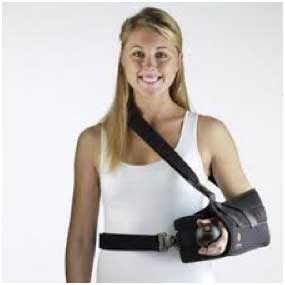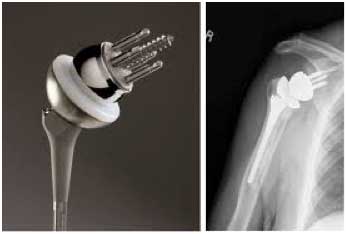Reverse Shoulder Replacement
Reverse Shoulder Replacement is a shoulder implant that has been used successfully for over ten years in Europe. It specifically designed for use in shoulders that have a deficient rotator cuff and severe arthritis. In addition, it can be used in the setting of complex fractures and failure of previous shoulder replacements in which the rotator cuff has become deficient.
Preparing for Reverse Shoulder Replacement Surgery
· Medical Evaluation
Most patients must have a complete physical by their primary care doctor before surgery. This is needed to make sure you are healthy enough to have the surgery and complete the recovery. Many patients with chronic medical conditions, like heart disease, must also be evaluated by a specialist, such a cardiologist, before the surgery.
· Medications
Be sure to talk to your orthopedic surgeon about the medications you take. Some medications may need to be stopped before surgery.
- Non-steroidal anti-inflammatory medications, such as aspirin, ibuprofen, and naproxen sodium
- Most arthritis medications
- If you take blood thinners, either your primary care doctor or cardiologist will advise you about stopping these medications before surgery.
Home Planning
Making simple changes in your home before surgery can make your recovery period easier. For the first several weeks after your surgery, it will be hard to reach high shelves and cupboards. Before your surgery, be sure to go through your home and place any items you may need afterwards on low shelves. When you come home from the hospital, you will need help for a few weeks with some daily tasks like dressing, bathing, cooking, and laundry. If you will not have any support at home immediately after surgery, you may need a short stay in a rehabilitation facility until you become more independent.
Reverse Shoulder Replacement Surgical Procedure
Your anesthesiologist and your surgeon will discuss the type of anesthesia to be used. You may be provided a general anesthetic (you are asleep for the entire operation), a regional anesthetic (you may be awake but have no feeling around the surgical area), or a combination of both types. This procedure to replace your shoulder joint with an artificial device usually takes about 2 hours. Your surgeon will make an incision either on the front or the top of your shoulder. He or she will remove the damaged bone and then position the new components to restore function to your shoulder
 Reverse Shoulder Replacement Recovery
Reverse Shoulder Replacement Recovery
After Reverse Shoulder Replacement Surgery your medical team will give you several doses of antibiotics to prevent infection, and pain medication to keep you comfortable. Most patients are able to eat solid food and get out of bed the day after surgery. You will most likely be able to go home on the second or third day after surgery.
Rehabilitation
- When you leave the hospital, your arm will be in a sling.
- Your surgeon may instruct you to do gentle range of motion exercises to increase your mobility and endurance. A formal physical therapy program may also be recommended to strengthen your shoulder and improve flexibility.
- You should be able to eat, dress, and groom yourself within a few weeks after surgery.
- Your surgeon may ask you to return for office visits and x-rays in order to monitor your shoulder.
Risks
It is important to be on the lookout for signs and symptoms of infection following
Surgery. These include: fever, chills, nausea, vomiting, diarrhea, and redness around your Incision. Watch for yellow/green drainage from your incision. Should you have any of these symptoms please contact your surgeon’s office immediately.

